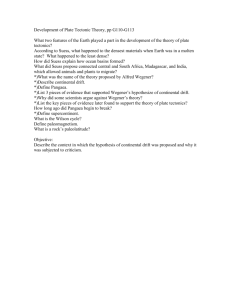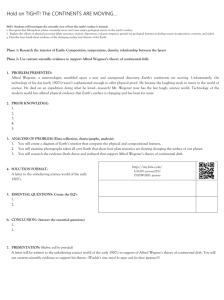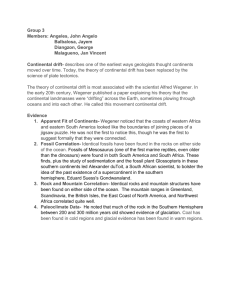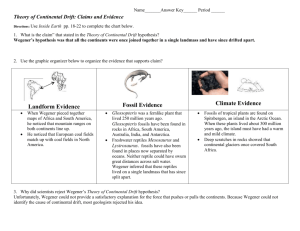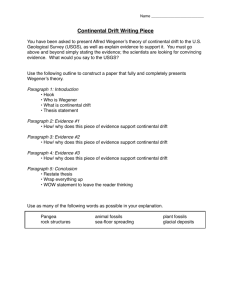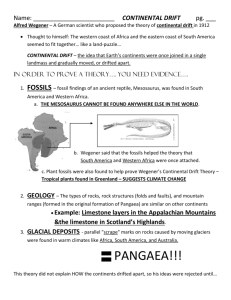Plate Tectonics 2
advertisement
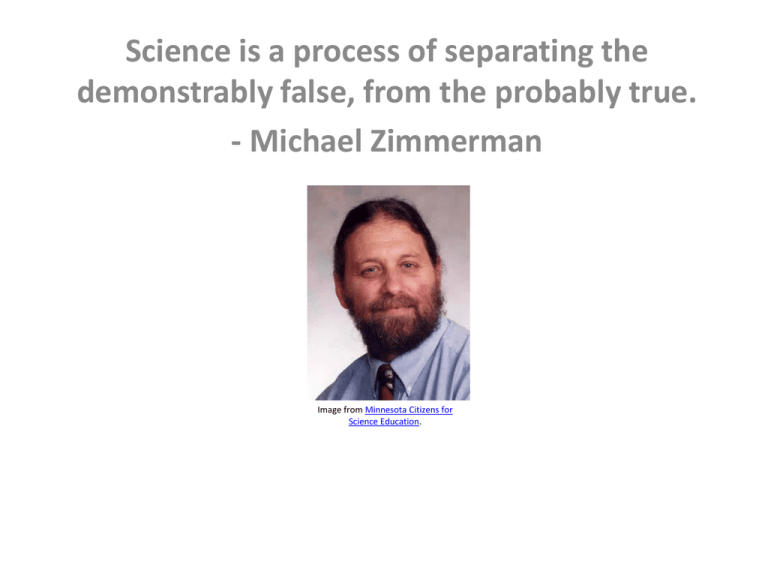
Science is a process of separating the demonstrably false, from the probably true. - Michael Zimmerman Image from Minnesota Citizens for Science Education. This is a case of extraordinary science! "If we are to believe [this] hypothesis, we must forget everything we have learned in the last 70 years and start all over again” –R. Chamberlin (American geologist) Image from Wikipedia used under educational use rationale. During the plate tectonics revolution, geologists get rid of most of their large-scale INTERPRETATIONS (NOT observations) of the planet works. This occurs with paradigm shifts. Evidence for the theory of continental drift: 1) The shapes of continents match 2) The geological maps match (stratigraphy & others) 3) The fossil match (paleontological) 4) The rocks record features that indicate that ice was present in the past (paleoclimatic) This evidence is all geologic and mostly qualitative. Evidence for the theory of plate tectonics: 1) Deep earthquake epicenters located along dipping plane (1930s). 2) Paleomagnetic evidence indicating that the N pole drifted over time (1950s). 3) Maps of seafloor indicating a mountain range in middle of the Atlantic (1950s) 4) Magnetic reversals on seafloor, suggesting seafloor is spreading and youngest in the middle (1940s, 1950s). 5) Models of the Earth consisting of 12 rigid tectonic plates (1960s). This evidence is all geophysical and quantitative. 1930s Image from biography on the Pennsylvania State University website. Kiyoo Wadati of Japan 1950s Earth’s magnetic field Image source. Image credit: Paleomagnetism Chapter 10 by Robert Butler, University of Arizona. Image from Wikipedia used under educational reuse rationale. Marie Tharp Bruce Heezen Harry Hess Image courtesy of PBS.org. Aye, aye, Captain Diagrams depicting mid-ocean ridges and normal vs. reversed magnetic polarity. Can be obtained from Don Reed’s website (San Jose State University) . Image source: Müller, R.D., M. Sdrolias, C. Gaina, and W.R. Roest 2008. Age, spreading rates and spreading symmetry of the world's ocean crust, Geochem. Geophys. Geosyst., 9, Q04006,doi:10.1029/2007GC001743. Image obtained from NOAA. In 1967, W. Jason Morgan proposed that the Earth's surface consists of 12 rigid plates that move relative to each other. Two months later, in 1968, Xavier Le Pichon published a complete model based on 6 major plates with their relative motions. Le Pichon Morgan Image courtesy of Princeton Weekly Bulletin. Image from Le Pichon’s Facebook site. Image courtesy of USGS. Geologists have been working for now 40 years trying to test and refine the theory of plate tectonics. This is a return to “normal science” in Kuhn’s sense. Is plate tectonics a good scientific theory? It is a theory because it: 1) Explains scientific observations; 2) Is tested with repeated observations and found always to work; and 3) Is accepted by the scientific community. A good scientific theory: 1) YES! Logical consistency - parts of it don’t contradict other parts 2) YES! Agrees with the data. 3) YES! Suggests verifiable causes that explain and predict BUT, note that it doesn’t explain how plates moves. What happens to continental drift? The theory of continental drift is added as a part of the theory of plate tectonics. This “engulfing” of one theory by another theory is relatively common. And now to boldly go where science classes don’t – the nature of science Image removed due to copyright: USS Enterprise. Why did North American Scientists reject the Theory of Continental Drift 1) Methodological differences of the geologists (uniformitarianism & multiple working hypotheses) 2) Role of Isostacy 3) Emphasis on physics-based approaches (instrumentation and theoretical approaches) I’ll provide some nature of science commentary Image courtesy of Ragesoss. Back to G.K. Gilbert. He came up with a very good way of collecting empirical field data: Multiple working hypotheses. It is still used by field geologists, because it works very well. Image courtesy of USGS. G. K. Gilbert Multiple working hypotheses Geologists are faced with a baffling array of features in any area, of which they have to make sense. The so-called scientific method (observation->prediction->hypotheses>experiment) doesn’t work very well. Gilbert notices that rather than only forming one hypothesis, it is better to have several in mind and see which one fits the facts better. Image from Wikimedia Commons. The idea of multiple working hypotheses is picked up by T.C. Chamberlin, a major intellectual force at the time. Chamberlin was at the University of Wisconsin, for a good portion of his academic career. He was also president or the University (He eventually moved to the University of Chicago). I am confident, therefore, that general application of this method to the affairs of social and civic life would go far to remove those misunderstandings, misjudgments, and misrepresentations which constitute so pervasive an evil in our social and our political atmospheres, the source of immeasurable suffering to the best and most sensitive souls. Image source: Wikimedia Commons. Hmmm, sounds almost like a political statement. Naomi Oreskes Image source: Oreskes’ faculty page, UCSD. Oreskes maintains that the concept of “multiple working hypotheses” is a particularly American invention. It embodies the broadest and deepest convictions of Americans: It was the idea that all ideas have their place and should be treated equally and fairly. Further, it was a reaction to the way geological science was being conducted in Europe, mostly following the theoretical musings of prominent scientists that were not based on observations. Multiple working hypotheses therefore becomes THE methodological way that geological science gets done. I am confident, therefore, that general application of this method to the affairs of social and civic life would go far to remove those misunderstandings, misjudgments, and misrepresentations which constitute so pervasive an evil in our social and our political atmospheres, the source of immeasurable suffering to the best and most sensitive souls. Image source: Wikimedia Commons. It IS a political statement. Naomi Oreskes Image source: Oreskes’ faculty page, UCSD. Plus, it outlived its place in geology as fieldwork lost the center stage. Which leads us back to Wegener and his theory of continental drift…. Image from Wikimedia Commons. …and the American criticism. "Utter, damned rot!” -W.B. Scott "If we are to believe [this] hypothesis, we must forget everything we have learned in the last 70 years and start all over again” -American scientist "Wegener's hypothesis in general is of the footloose type, in that it takes considerable liberty with our globe, and is less bound by restrictions or tied down by awkward, ugly facts than most of its rival theories." - Dr. Rollin T. Chamberlin (TC Chamberlin’s son) By declining to consider alternative frameworks, Wegener violated the American ideal of applying democratic principles to the development of scientific theory. Image courtesy of Ragesoss. Hmmm, I wonder what else I did wrong? Image source: USGS. Alfred W. For the record, the “official” scientific line for rejection of continental drift was the lack of a mechanism. Wegener assumed that the continents moved through the rocks at th at made up the oceanic crust. Thus , the ma jor probl e m was findi n g forces that could make the co n tin ents "plow around in the mantle " (in the words of a critic ). Wegener tentatively suggested both centrifugal force ca u s ed by the rotation of the Ea rth (whi ch would move continents to the equator ) and tidal - type waves in t he Earth itself generated by the gravitati o nal pu ll of the sun a nd moon. Wegener suspected these forces were inadequate to mo ve contients . "It is probable the complete solution of the problem of the forces will be a long time coming," he predicted in his l ast (1929 ) revision. "The Newton of drift t heory has not yet appea red." If he does appear, after being dead for 2 centuries, Did you hear what I say let’s throw an apple the man said and make a run for it. Image removed The Newton hasn’t due to copyright: appeared. Statler and Waldorf Jim Henson puppets. This makes no sense. Plate tectonics, when accepted, also lacks a mechanism. That is, why do not know why the plates move. Image courtesy of Ragesoss. Hmmm, this isn’t what I was taught, but it is correct. The development of scientific knowledge is inescapably historical, because scientists make choices based on biases (methodological, disciplinary, and evidential). While it was easier to be a field geologist without this information, I am a better field geologist with more scientific integrity knowing it. There were other social problems: 1) Wegener was not a geologist, and therefore lacked credibility; 2) The evidence was from the southern hemisphere, so most geologists from Europe and US had not seen the data; and 3) The geophysical community, particularly in North America, did not accept the idea (for reasons that are about to be explained). How did we get into a continental drift lecture? Image removed due to copyright: Statler and Waldorf Jim Henson puppets. I think because everything’s gone (drifted) South. The US geophysical community was a bit of an obstacle. Come to the dark side. Accept theoretical constructs and the precise instrumental measurements only. Image removed due to copyright: Darth Vader. Image from Wikimedia Commons. Image from NOAA, found on Wikipedia. Ok, really, they didn’t look that mean, but they did basically stop continental drift from happening – by studying a principle called isostacy. Hayford Bowie A brief summary of isostacy Amazing! Image from Wikimedia Commons. During the survey of India by the British in the 1800s (headed up by Sir G. Everest), they noticed an amazing thing: A plumb bob is deflected from vertical by the Himalayan mountains. Hmmmm. Image from Wikimedia Commons. It turns out, one would expect that result because the mountains are exerting a gravitational force. The problem was that the deflection was LESS than it should have been. Two possibilities were proposed: 1. The mountains have roots that sit in the Earth’s mantle (the next layer down), very much like an iceberg. This is called Airy isostacy; or 2. The crust has a constant thickness, but the density of rocks below the mountains is less than that below the plains. This is called Pratt isostacy. Airy isostacy Pratt isostacy U.S. Coast & Geodetic Survey It turns out, when you try to make an accurate map, you need to know a precise shape for the shape of the Earth. It turns out that G.K. Gilbert (remember him?) figured out a way of doing that by measuring gravity very precisely everywhere. Image from Wikimedia Commons. Hayford, however, carries it one step farther and makes even better calculations. He found the same results as before, that the deflections were too small (as did Pratt before him). Therefore, he assumes Pratt’s model is correct. “There must be some general law of distribution of subsurface densities which fixes a relation between subsurface densities and the surface elevations…” So, scientists generally accept this METHOD because it is quite effective at making maps. They also assume that the MODEL is correct (which is incorrect). So, Isostacy becomes fact. “Isostasy must, today, be regarded as fact which has been tested by many observation…Hayford’s work in America (later Hayford’s and Bowie’s) may be regarded as having decisively elevated theory into fact.” -Sir Harold Jeffreys Theories are not uniquely confirmed by their predictions…Theories can be right in some respects and wrong in others. The Pratt model of isostacy was correct with respect to the existence of isostatic compensation, but not with respect to how that compensation was achieved. Image courtesy of Ragesoss. Image from Wikimedia Commons. Hayford, Bowie, and Jeffreys form a powerful alliance against continental drift. In fact, they do not even consider that geological evidence is worth considering. I don’t even consider continental drift as an option, because is violates the “truth” of Pratt isostacy. So, things are not looking so good for Wegener. Nicht so gut. Image source: USGS. Image removed due to copyright – Gary Larsen’s The Far Side Continental Drift -- Whiplash The geophysicists would not accept any inductive, geological evidence. They would only trust their theoretically driven, quantitative data. Image courtesy of Ragesoss. Oreskes proposes as evidence of this statement the “Bullard fit” (how the continents fit back together). This reconstruction was proposed by geophysicist Bullard at Cambridge University, and used as evidence by the geophysical community for plate tectonics (it appeared in most textbooks for the next 30 years). Oreskes maintains that this map was NOTHING that Wegener had not proposed before. From Walter Munk (distinguished geophysicist) "In this controversy between physicists and geologists, the physicists, it would seem, have come out second best! They gave decisive reasons why polar wandering (read: continental drift) could not be true when it was weakly supported by paleoclimatic evidence, and now that rather convincing paleomagnetic (i.e. physical) evidence has been discovered, they find equally decisive reasons why it could not have been otherwise." Nature of science Oreskes starts her chapter with this quote by J.S. Mill: “While everyone well knows himself to be fallible, very few think it necessary to take precautions against their own fallibility.” How does this quote relate to her chapter and Feynman’s idea of scientific integrity? "The young specialist in English Lit ... lectured me severely on the fact that in every century people have thought they understood the Universe at last, and in every century they were proved to be wrong. It follows that the one thing we can say about our modern 'knowledge' is that it is wrong. ... My answer to him was, '... When people thought the Earth was flat, they were wrong. When people thought the Earth was spherical they were wrong. But if you think that thinking the Earth is spherical is just as wrong as thinking the Earth is flat, then your view is wronger than both of them put together.” - Isaac Asimov Did Wegener know this theory was going to be a bit, well, controversial? "if it turns out that sense and meaning are now becoming evident in the whole history of the Earth's development, why should we hesitate to toss the old views overboard?” - letter to future father-in-law, well-known climatologist Wladimir Koppen Image source: Wikipedia, US public domain. Sounds like a scientist. Image removed due to copyright: Statler and Waldorf Jim Henson puppets. Sounds like he’s never getting married.
